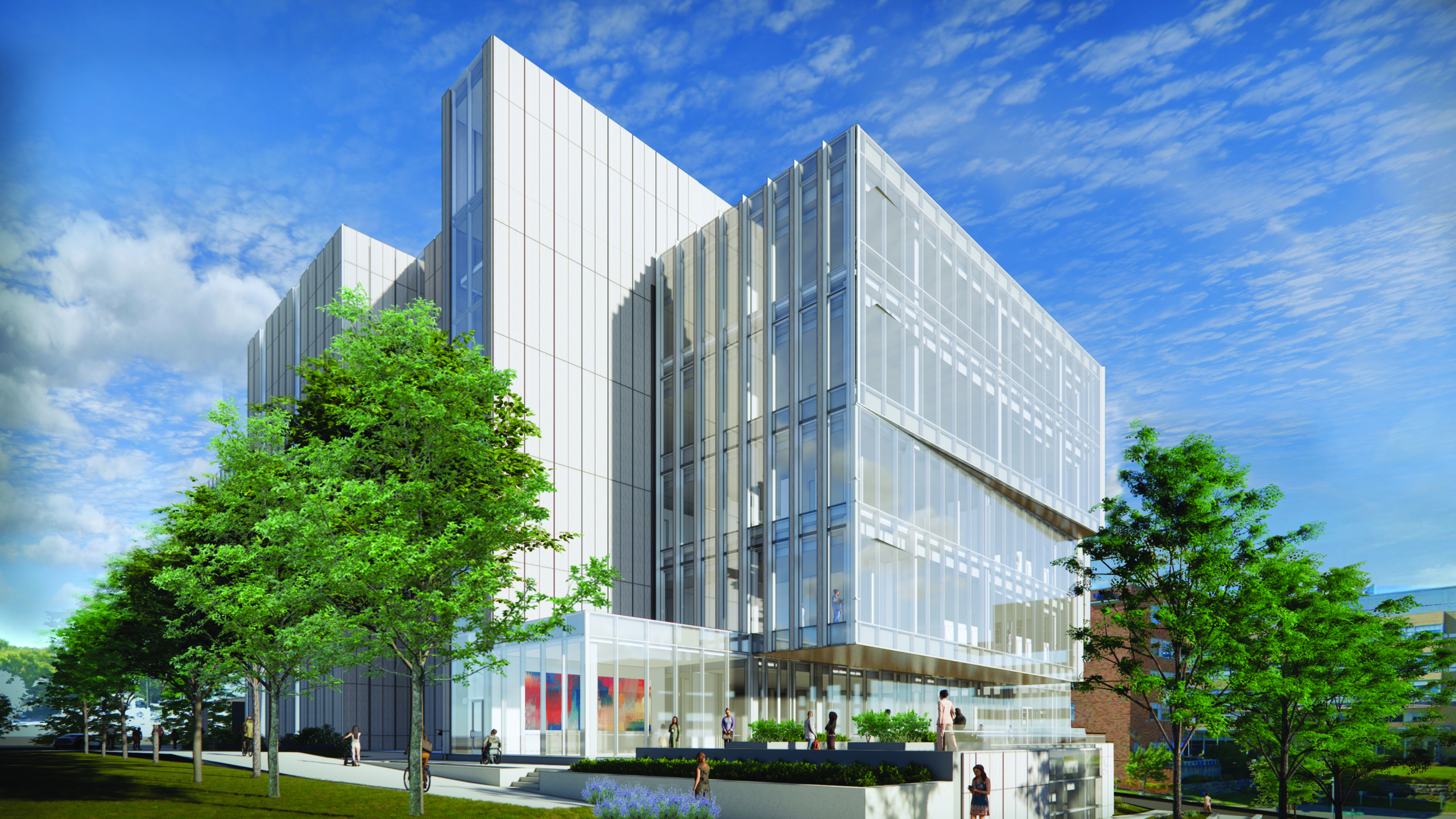New Healthcare Delivery and Innovation Building will elevate patient care and allow students to enhance their skills with the latest technology
By Bryce Puntenney
In more than 50 years of serving patients in the current UMKC School of Dentistry building,
faculty, staff and students have learned a lot about what makes dental clinics efficient, patient-focused and effective at educating students. The planners of the new state-of-the- art UMKC Healthcare Delivery and Innovation Building relied heavily on that expertise and have designed clinics that will eliminate bottlenecks in X-ray and sterilization areas, added new technology to see patients virtually and even brought in more natural light, all to better serve the school’s mission of advancing patient care and developing skilled oral health-care providers.
“The stuff we’re doing in dentistry wasn’t even dreamt of when the current building was built, but whoever designed it did a great job,” said Lance Godley, D.M.D., M.Ed. “Our building has served us well for 50 years. Whoever comes after us, we want this new building to hopefully be nimble enough to incorporate new dental techniques and technological advances another 50 years.”
As associate dean for clinical affairs, Godley is part of a group of school administrators attending planning meetings for the building, which will break ground next year and is expected to be completed in 2026. In addition to the school’s clinics, the multi-disciplinary building will house the UMKC School of Medicine simulation labs, the UMKC biomedical engineering program collaborative space, as well as the UMKC Health Equity Institute and the Data Science and Analytics Innovation Center. More than 60% of the six-story, 200,000-square-foot facility will be dedicated to the School of Dentistry.
Clinical Excellence
The $120 million building will be constructed on what is now a parking lot at 25th and Charlotte streets and will be the largest capital investment by the university to date.
The planning for the dental portion of the building has been a school- wide effort, with architects and engineers meeting regulary with students, faculty and staff.
Godley said the bottlenecks that occur in two areas of the current building — radiology and sterilization — will be addressed in the new building. Currently, both serve the entire clinical floor and the hundreds of student clinicians at work, and both the clinician and their patient must wait in line for services. The new leading-edge pre-doctoral clinics will be spread across three floors, which means rethinking the existing centralized sterilization process that has been the norm for many years.
Moving forward, all sterilization will happen on the first floor, where a dedicated elevator will be used to dispense and collect instruments. Each student will have a storage locker the size of a mailbox within their clinics, with access on one side for the student and on the other for the sterilization staff. Students will pre-order instruments, which will then be delivered to their mailbox. No more standing in line.
The logjam created in radiology will receive some relief by dispersing X-ray units throughout each clinic floor. Currently, one radiology clinic serves all student clinicians seeing patients. Whether it’s routine X-rays or complicated dental issues, all radiology needs now go through this central location.
In the new building, students won’t be competing with everyone in the clinic. Radiology services will still include a centralized clinic for complicated cases, but the new clinics will also provide additional X-ray units dispersed on multiple floors, with the four operatories in each clinic team equipped to take radiographs.
The dedication to efficiency will be best represented in the new acute care clinic in the Healthcare Delivery and Innovation Building.
Currently, the school has separate clinics for oral surgery, endodontics and emergency services, each in different areas of the building. Those clinics will be combined in one acute care clinic, which will operate as its own dental clinic, providing everything from oral surgery to restorative dentistry. The school is also exploring keeping the acute care clinic open some nights and weekends for dental emergencies that occur after the clinic’s regular business hours.
“The students won’t just diagnose a patient’s problem in the emergency care clinic and then have to send the patient up to another student on the third floor who’s on rotation for oral surgery, or over to another student in the endodontic clinic,” Godley said. “In the acute care clinic, students will provide beginning-to-end care.”

Student Perspective
Students have been integral in the planning process and Godley said it’s been eye-opening to find out what’s important to them. Security was top-of-mind. The nature of the clinics means the public will have access to the building, so the school will balance accessibility with security.
The new clinics will be secured by badges that provide clearance to specific areas. For patients, the building will be equipped with self-check-in kiosks, relieving another bottleneck that occurs in the current building. Patients will receive access only to the areas they need for their appointments.
Fourth-year dental student Van Hopkins was impressed that administrators and architects sought out student input. The planners laid out changes they were contemplating and asked students to weigh in.
“Clinically, we have a lot of advantages over dental students in other settings,” Hopkins said. “We come out of school with a lot of experience. We’re very blessed, but that doesn’t mean there aren’t things that can be improved.”
Students prioritized the inclusion of natural light in the new building, in contrast to the current windowless clinics in the current dentistry building. According to Hopkins, students sometimes arrive at the building in the dark and leave in the dark. He and others connect natural light with better well-being for patients, students, faculty and staff.
Third-year dental student Nhukha Nguyen said she is excited about the endless possibilities the cutting-edge technology in the new building will provide, especially the school’s push to the forefront of teledentistry. “This will be a huge breakthrough for underserved populations and individuals with disabilities who may not have access to traditional dental care,” Nguyen said. “Teledentistry will provide more accessibility for patients who do not have time to go to the dentist.”
Visionary Leadership
According to Dean Steven Haas, the improved efficiency will allow for an increased amount of uncompensated care provided by students. Right now, the school delivers about $600,000 a year, but he is confident that could easily go up to $1 million. The goal is to deliver care faster, at a lower cost, while keeping the standard of care at the highest level.
“Dentists are always servant leaders,” Haas said. “From the very day our students enter the school, every minute of information they receive is geared toward patient care.”
With the new acute care clinic, the school will have more capacity to take on emergency dental cases. Before Haas entered academia, he worked in a variety of oral health-care clinics, including hospitals. There, he saw dental cases that ended up in emergency rooms. Many hospitals are not equipped to provide care for those dental emergencies beyond pain mitigation. The new acute care clinic will help alleviate that tremendous burden on the hospital system.
Students and patients will also benefit from a new high-tech dental design lab to produce crowns, bridges, and implants. Haas was moved by the broad support the building has received. The project
is close to being fully funded. The state of Missouri committed $60 million, the Sunderland Foundation has pledged $30 million, the Hall Family Foundation will contribute $15 million and $10 million will come from federal funding secured by former U.S. Senator Roy Blunt.
For Haas, that coalition is a testament to the vision UMKC Chancellor Mauli Agrawal has for the Health Sciences District. Agrawal saw the importance of the school’s dental clinics and the role the building could play as a catalyst to launch a new era for the district and health-care access.
“The fact that the chancellor’s vision saw dentistry as a priority shows how important this new building is,” Haas said. “When you invest in a state-of-the-art building that visually stands out, people will take notice that Kansas City is a serious health-care hub.”
Campus, community and political leaders joined the UMKC Health Sciences community to celebrate that vision and the future building with an unveiling event on Oct. 17, on the lawn across the street from the building site. In front of the group of supporters, Agrawal reiterated his vision.
“The new Healthcare Delivery and Innovation Building will be one of a kind,” he said. “We know of only one other combined medical and dental education building in the nation and none other that will include what ours will, with a unique combination of collaborative programs focused on elevating health care.”


